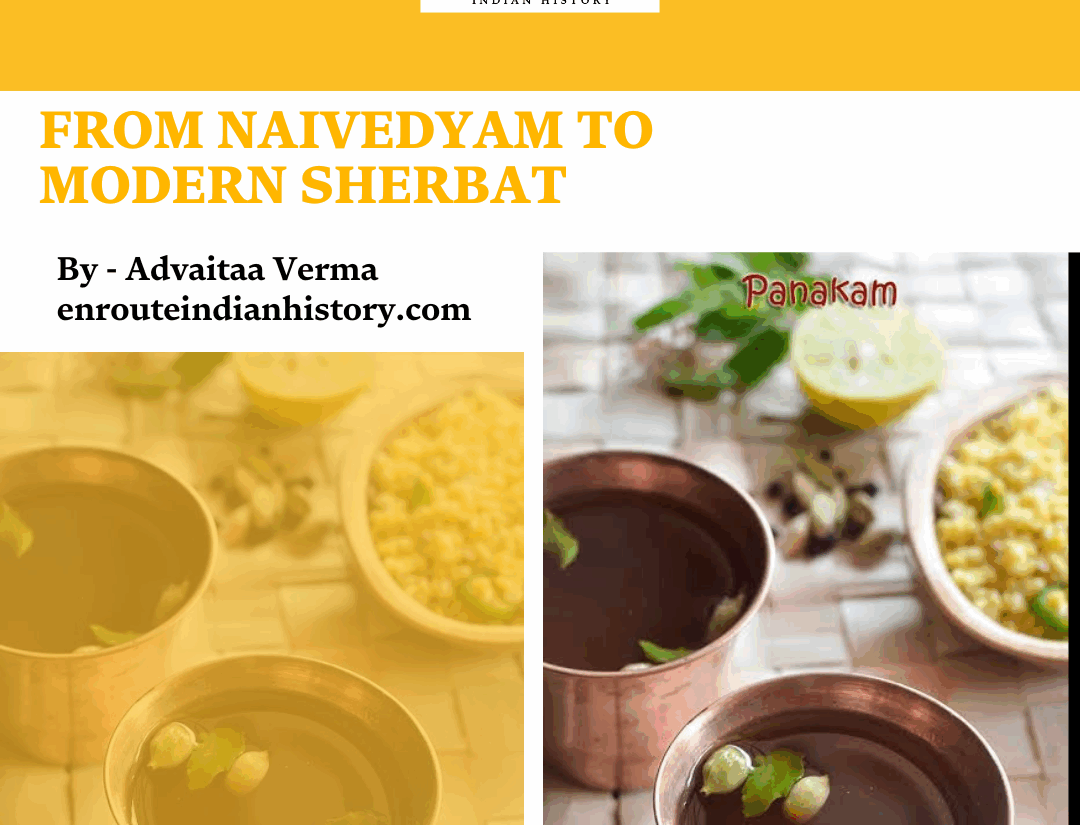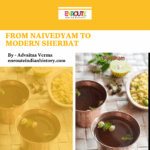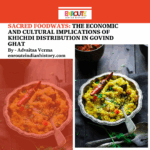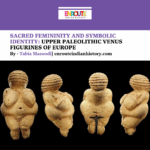
By Advaitaa Verma
Panakam (also spelled panagam), an ancient South Indian drink traditionally made with jaggery, dry ginger, cardamom, pepper, and water, exemplifies the sacredness of food in Indian religious life. Unlike the ornate and often opulent offerings found in North Indian temple cuisines, Panakam is humble, rustic, and deeply tied to climatic and regional realities. At once a votive offering (naivedyam) and a physiological remedy for summer heat, its ritual significance and physiological relevance provide a compelling case study of how religious foodways intersect
with wellness practices and environmental adaptation (Hartvig, 2016). Panakam in South Indian temples is served as prasadam and is ritually a highly significant drink and is offered during peak summer festivals. In Tamil Nadu and Andhra Pradesh, Panakam has long been offered in Vaishnavite temples, especially during Rama Navami, the celebration of Lord Rama’s birth, which falls in the searing heat of the Chaitra month (March–April). It is believed that Rama, an incarnation of Vishnu, preferred simplicity and temperance—values + reflected in the nature of offerings made in his name (Singh, 2023).
Temples such as the Rama Temple in Bhadrachalam (Telangana, historically part of Andhra Pradesh) and the Ramaswamy Temple in Kumbakonam (Tamil Nadu) are prominent centers where Panakam plays a central ritualistic role. Devotees are not only offered Panakam as prasadam but also participate in its preparation in community kitchens, blending devotion with physical service (seva). In these spaces, Panakam transcends its status as a beverage and becomes a medium of communion and collective religious identity (Singh, 2023). Unlike other offerings which are more standardized throughout the year, Panakam is distinctively seasonal. Its use peaks in the hot season, where it is believed to have a shamana (cooling and pacifying) effect according to Ayurvedic principles(Singh, 2023). This synergy between spiritual and bodily healing reflects a profound integration of environmental mindfulness into ritual life. This article traces how this sacred ritualistic drink transitioned into being summer coolers in South Indian urban households and restaurants.
Ingredients and Symbolism
Panakam’s potential as both a sacred and seasonal beverage lies not only in its function but also in the careful selection of its ingredients, each bearing ritual, medicinal, and symbolic significance within South Indian religious and cultural frameworks. Far from being a mere mixture, Panakam is a carefully calibrated formula of Ayurvedic principles, sacred culinary aesthetics, and environmental intelligence. Each element in Panakam resonates with both
cosmological and physiological harmonies, making it a paradigmatic example of sacred
sustenance (Garg & Simgh, 2024).
● Jaggery : It is an unrefined cane sugar. According to Vedic rituals, jaggery is considered a sattvic sweetener, signifying purity, prosperity, and divinity. Jaggery is known for its warming yet non-heating nature, making it an ideal ingredient in summer drinks like panakam.
● Dry ginger and pepper: Ginger is considered a digestive stimulant, and is often used in Vedic fire rituals as ginger symbolizes purity. In ayurveda, ginger is significant, as it helps in removing toxins from the body and mitigates heat exhaustion without overcooling the body. Spices like pepper act as a metabolic stimulant and also has a post- digestive cooling effect.
● Cardamom: Considered sacred in Vedic rituals, also has been a part of temple kitchens as well. Its aroma is said to please the gods, and it is associated with the sweetness of divine speech and prayer.
● Tulsi leaves: It is added occasionally and is revered in Vaishnavism, Tulsi sanctifies the offering. It also boosts immunity and modulates stress responses. It is cooling and spiritually uplifting (Singh, 2023).
Transition: Temples into Households
With urbanization and the diaspora of temple culture into domestic spaces, especially in Tamil Brahmin and Telugu-speaking households, Panakam began to be prepared at home during summer—not just as an offering but as a coolant drink for everyday consumption (Caplan, 2013). In Chennai, Madurai, Hyderabad, and Vijayawada, recipes for Panakam became household lore, passed from grandmothers to younger generations, often featuring slight regional variations. The use of palm jaggery in coastal Tamil Nadu or the inclusion of lemon juice in Andhra-style
Panakam reflects these micro-adaptations. Moreover, Panakam retained its ritual significance in home altars, especially during Rama Navami, but became increasingly appreciated for its health benefits during extreme summer months (Hartvig, 2016). In the 21st century, with the wellness movement's focus on natural, sugar-free, heritage beverages, Panakam has found a renewed life. Urban cafes and Ayurvedic restaurants in
Chennai, Bengaluru, and Hyderabad are now reviving Panakam under the banner of “heritage
coolers” or “spiced summer tonics.”
Restaurants like Amethyst Café in Chennai and Santé Spa Cuisine in Hyderabad, which is now permanently closed, feature reimagined versions of Panakam; sometimes chilled, infused with tulsi hydrosol, or paired with millet-based desserts. Panakam has moved from the sacred to the aesthetic, no longer only religious but now a sensorial and cultural marker of South Indian identity (Caplan, 2013).
Temples and the Continuity of Practice
Despite the secularization and commercialization of Panakam, South Indian temples remain the living custodians of its original sacred context. In major Vaishnavite temples of Tamil Nadu and Andhra Pradesh, Panakam features prominently in summer rituals and festival-specific naivedyam (food offerings). These temples operate on a cosmo-agricultural calendar, and the offerings adapt seasonally, attuned to climatic conditions, deity moods, and human physiology. The Chaitra and Vaishakha months (March to May), characterized by oppressive heat, are precisely when cooling, sattvic, and hydrating preparations like Panakam are ritually emphasized. In temples such as Ahobilam Temple in Andhra Pradesh), where Panakam is offered during Brahmotsavam; Parthasarathy Temple in Triplicane (Chennai) is known for seasonal naivedyam rotations; Srirangam Ranganathaswamy Temple, where the summer
calendar includes Panakam offerings in specific shrines of Rama and Krishna. In these temples, the preparation and distribution of Panakam are still seen as acts of merit (punya), ensuring both bodily cooling and spiritual elevation (Hartvig, 2016).
Panakam’s journey from a ritualistic offering in sweltering temple courtyards to a refined urban wellness drink encapsulates the enduring interplay between faith, climate, health, and taste in South Indian culture. It serves as a reminder of how ancient practices, rooted in religious experience and environmental adaptation, can be reimagined to meet contemporary needs. In South Indian temples—especially those venerating Lord Rama—it remains not just a customary offering but a climate-responsive ritual act. Its seasonal emergence during peak summer festivals such as Rama Navami and Chaitra Brahmotsavams links religious devotion with ecological rhythms, demonstrating how ritual calendars are often sophisticated meteorological systems encoded in faith. In contrast, the beverage’s modern resurgence in urban spaces as heritage coolers, Ayurvedic summer tonic, or sugar-free sherbat alternative, is both a cause for optimism and critique. In an era of global climate crises and rising health consciousness, Panakam is not just a relic of the past but it is a living, evolving testament to the power of sacred nourishment, regional resilience,
and culinary continuity.
References
Caplan, P., 2013. Food in middle-class Madras households from the 1970s to the 1990s. In Asian Food (pp. 46-62). Routledge.
Garg, P., Farooqi, R., Garg, Y., Kala, D. and Singh, S., 2024. Using Nostalgic Emotions to Revive Indian Ethnic Drinks Market: Competitive Strategy at Paper Boat. FIIB Business Review, 13(3), pp.294-303.
Hartvig, K., 2016. Healing Spices: 50 Wonderful Spices, and How to Use Them in Health-giving, Immunity-boosting Foods and Drinks. Duncan Baird Publishers.
Singh, R.P., 2023. Symbolism, sacrality, and foodscapes in Hindu pilgrimage system. D. Munro, B. Noel, H. Daniel, & Olsen (Eds.), Food, the pilgrim, and faith-based travel, pp.121-134.

















